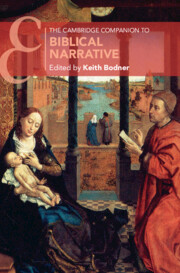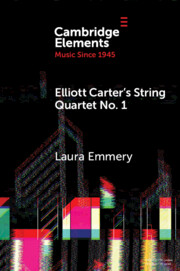241 results
Chapter 7 - The Camaraderie of Influence
- from Part II - Being
-
-
- Book:
- Latinx Literature in Transition, 1848–1992
- Published online:
- 10 April 2025
- Print publication:
- 17 April 2025, pp 126-142
-
- Chapter
- Export citation
NEC VANA FIDES. THE INTERTEXTUAL BACKGROUND OF A LAW OF VALENTINIAN III (NOV. VAL. 23) AND THE DATE OF THE VERSVS AD GRATIAM DOMINI
-
- Journal:
- The Classical Quarterly , First View
- Published online by Cambridge University Press:
- 03 April 2025, pp. 1-15
-
- Article
-
- You have access
- Open access
- HTML
- Export citation
6 - Metaphor
-
- Book:
- Language, Image, Gesture
- Published online:
- 08 January 2025
- Print publication:
- 13 February 2025, pp 141-174
-
- Chapter
- Export citation
7 - Co-text Images
-
- Book:
- Language, Image, Gesture
- Published online:
- 08 January 2025
- Print publication:
- 13 February 2025, pp 175-214
-
- Chapter
- Export citation
7 - Ruth and Jonah
-
-
- Book:
- The Cambridge Companion to Biblical Narrative
- Published online:
- 30 January 2025
- Print publication:
- 06 February 2025, pp 136-151
-
- Chapter
- Export citation

The Cambridge Companion to Biblical Narrative
-
- Published online:
- 30 January 2025
- Print publication:
- 06 February 2025
Epilogue
-
- Book:
- The Environmental Poetry of Augustan Rome
- Published online:
- 12 December 2024
- Print publication:
- 19 December 2024, pp 258-280
-
- Chapter
- Export citation
Chapter 1 - Introduction: Virgil and the Propertian Sensibility
-
- Book:
- Propertius and the Virgilian Sensibility
- Published online:
- 28 November 2024
- Print publication:
- 05 December 2024, pp 1-59
-
- Chapter
- Export citation
Chapter 7 - Conclusions
-
- Book:
- Propertius and the Virgilian Sensibility
- Published online:
- 28 November 2024
- Print publication:
- 05 December 2024, pp 379-392
-
- Chapter
- Export citation

Elliott Carter's String Quartet No. 1
- Myths, Narratives, and Cold War Cultural Diplomacy
-
- Published online:
- 29 November 2024
- Print publication:
- 02 January 2025
-
- Element
- Export citation

Propertius and the Virgilian Sensibility
- Elegy after 19 BC
-
- Published online:
- 28 November 2024
- Print publication:
- 05 December 2024
Adam and the names
-
- Journal:
- Bulletin of the School of Oriental and African Studies , First View
- Published online by Cambridge University Press:
- 27 November 2024, pp. 1-26
-
- Article
-
- You have access
- Open access
- HTML
- Export citation
11 - How, and Why, the Athenians Painted Different Myths at Different Times
- from Part IV - Conceptual Contexts
-
-
- Book:
- Texts and Intertexts in Archaic and Classical Greece
- Published online:
- 14 November 2024
- Print publication:
- 21 November 2024, pp 256-283
-
- Chapter
- Export citation
7 - Intertextuality, ‘cf.’, and Fragmentary Drama
- from Part III - Drama
-
-
- Book:
- Texts and Intertexts in Archaic and Classical Greece
- Published online:
- 14 November 2024
- Print publication:
- 21 November 2024, pp 169-190
-
- Chapter
- Export citation
5 - Invoking Homer
- from Part II - Lyric and Epic
-
-
- Book:
- Texts and Intertexts in Archaic and Classical Greece
- Published online:
- 14 November 2024
- Print publication:
- 21 November 2024, pp 118-137
-
- Chapter
- Export citation
3 - Intertextual Effects in Early Epigram
- from Part I - Early Intertextuality
-
-
- Book:
- Texts and Intertexts in Archaic and Classical Greece
- Published online:
- 14 November 2024
- Print publication:
- 21 November 2024, pp 73-94
-
- Chapter
- Export citation
10 - Talk and Text
- from Part IV - Conceptual Contexts
-
-
- Book:
- Texts and Intertexts in Archaic and Classical Greece
- Published online:
- 14 November 2024
- Print publication:
- 21 November 2024, pp 235-255
-
- Chapter
- Export citation
13 - Isaiah in Intertextual Perspective
- from Part III - Isaiah as Literature
-
-
- Book:
- The Cambridge Companion to the Book of Isaiah
- Published online:
- 08 November 2024
- Print publication:
- 21 November 2024, pp 205-224
-
- Chapter
- Export citation
6 - Pindar, Bacchylides, Archaic Epic, and Intertextuality
- from Part II - Lyric and Epic
-
-
- Book:
- Texts and Intertexts in Archaic and Classical Greece
- Published online:
- 14 November 2024
- Print publication:
- 21 November 2024, pp 138-166
-
- Chapter
- Export citation
Introduction
-
-
- Book:
- Texts and Intertexts in Archaic and Classical Greece
- Published online:
- 14 November 2024
- Print publication:
- 21 November 2024, pp 1-28
-
- Chapter
- Export citation


